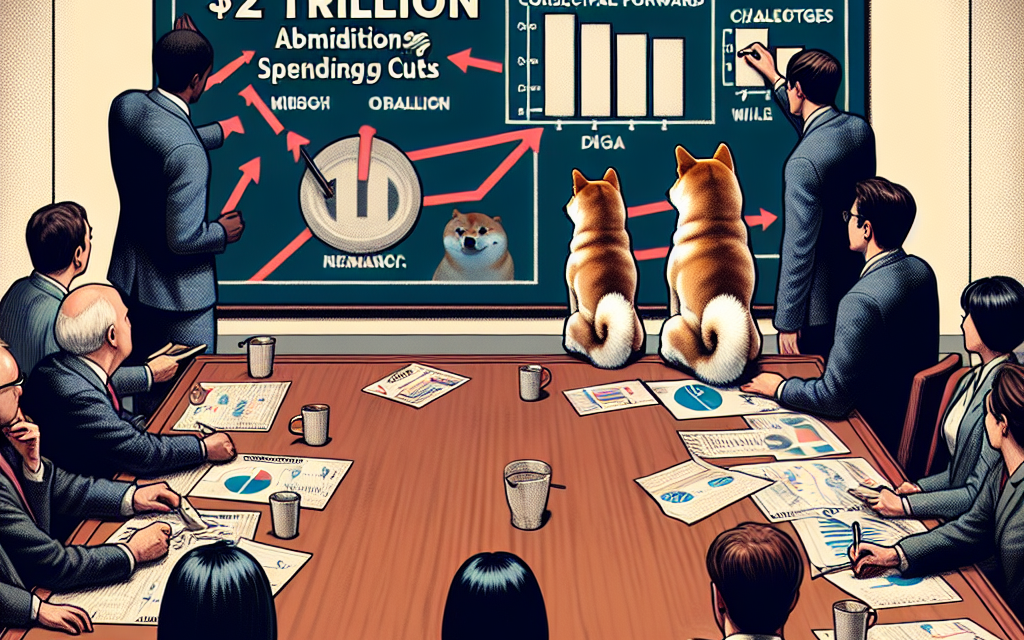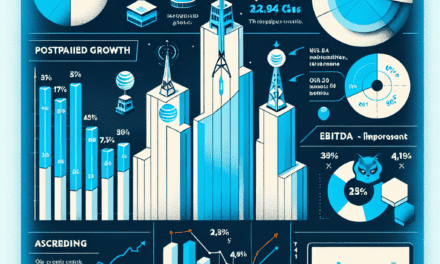“Bold Cuts, Big Challenges: DOGE Team’s $2 Trillion Ambition”
Introduction
The DOGE Team’s ambitious proposal to implement $2 trillion in spending cuts has sparked significant debate and faces numerous challenges as it moves through the legislative process. Aimed at addressing the national deficit and promoting fiscal responsibility, the plan outlines substantial reductions across various sectors, including defense, healthcare, and social services. However, the proposal has encountered resistance from both political opponents and stakeholders who argue that such drastic cuts could undermine essential public services and economic stability. As the team navigates these hurdles, the future of the proposal remains uncertain, highlighting the complexities of balancing fiscal austerity with the needs of a diverse populace.
Overview Of The DOGE Team’s $2 Trillion Spending Cuts Proposal
The DOGE Team’s proposal for $2 trillion in spending cuts has emerged as a significant point of discussion in economic and political circles. This ambitious plan aims to address the burgeoning national debt and streamline government expenditures. However, the proposal faces numerous challenges that could impede its implementation. To understand the complexities involved, it is essential to examine the components of the proposal, the rationale behind it, and the potential obstacles it may encounter.
At the heart of the DOGE Team’s proposal is a comprehensive review of federal spending, targeting areas deemed inefficient or redundant. The team has identified several sectors where cuts could be made, including defense, healthcare, and social welfare programs. By reallocating resources and eliminating wasteful spending, the proposal seeks to create a more sustainable fiscal environment. The proponents argue that such measures are necessary to prevent future economic instability and to ensure that government resources are used effectively.
The rationale behind the proposal is rooted in the growing concern over the national debt, which has reached unprecedented levels. The DOGE Team contends that without decisive action, the debt could have severe implications for the country’s economic health, potentially leading to higher interest rates and reduced investment in critical infrastructure. By implementing these spending cuts, the team believes it can set the nation on a path toward fiscal responsibility and long-term economic growth.
Despite the proposal’s intentions, it faces significant challenges that could hinder its progress. One of the primary obstacles is political opposition. Many lawmakers are wary of the potential impact of such drastic cuts on their constituents, particularly those who rely on government programs for essential services. The proposal’s critics argue that reducing funding for healthcare and social welfare could disproportionately affect vulnerable populations, exacerbating existing inequalities.
Moreover, the defense sector, which constitutes a substantial portion of federal spending, presents another challenge. Any attempt to reduce defense budgets is likely to encounter resistance from both political leaders and defense contractors, who argue that such cuts could compromise national security. Balancing the need for fiscal prudence with the imperative of maintaining a robust defense posture is a delicate task that requires careful consideration.
In addition to political hurdles, the proposal must also contend with economic realities. Implementing spending cuts on such a large scale could have unintended consequences for the broader economy. Critics warn that reducing government spending could lead to job losses in sectors dependent on federal contracts, potentially slowing economic growth. Furthermore, the timing of these cuts is crucial; implementing them during an economic downturn could exacerbate financial instability rather than alleviate it.
To navigate these challenges, the DOGE Team must engage in extensive dialogue with stakeholders across the political spectrum. Building consensus will be essential to ensure that the proposal is both effective and equitable. This may involve making concessions or adjustments to the original plan to address valid concerns raised by opponents.
In conclusion, while the DOGE Team’s $2 trillion spending cuts proposal is a bold attempt to address the national debt, it faces a complex array of challenges. Political opposition, economic considerations, and the need for consensus-building all play critical roles in determining the proposal’s viability. As the debate continues, it remains to be seen whether the DOGE Team can successfully navigate these obstacles and implement a plan that balances fiscal responsibility with social equity.
Key Challenges Facing The DOGE Team’s Ambitious Spending Cuts
The DOGE Team’s ambitious proposal to implement $2 trillion in spending cuts has sparked significant debate and analysis, as stakeholders from various sectors assess the potential impacts and challenges of such a substantial fiscal adjustment. As the team navigates the complexities of this proposal, several key challenges have emerged that could influence the feasibility and effectiveness of the proposed cuts.
To begin with, one of the primary challenges facing the DOGE Team is the identification of specific areas where spending can be reduced without adversely affecting essential services. The magnitude of the proposed cuts necessitates a careful examination of government programs and expenditures to ensure that reductions do not undermine critical public services such as healthcare, education, and infrastructure. Balancing fiscal responsibility with the need to maintain the quality and accessibility of these services is a delicate task that requires meticulous planning and stakeholder engagement.
Moreover, the potential economic repercussions of such significant spending cuts cannot be overlooked. Reducing government expenditure on this scale could have a contractionary effect on the economy, particularly if the cuts lead to job losses in the public sector or reduced investment in key industries. The DOGE Team must consider the broader economic context and potential ripple effects, ensuring that the cuts do not inadvertently stifle economic growth or exacerbate existing inequalities. This necessitates a strategic approach that includes measures to mitigate any negative economic impacts, such as targeted support for affected sectors or initiatives to stimulate private sector investment.
In addition to economic considerations, the political landscape presents another formidable challenge. Implementing $2 trillion in spending cuts is likely to encounter resistance from various interest groups and political factions, each with their own priorities and concerns. Building consensus and securing the necessary political support for the proposal will require adept negotiation and compromise. The DOGE Team must navigate a complex web of political interests, balancing the need for fiscal prudence with the demands of constituents and stakeholders who may be adversely affected by the cuts.
Furthermore, the implementation of such extensive spending cuts requires robust administrative capacity and oversight. Ensuring that the cuts are executed efficiently and transparently is crucial to maintaining public trust and confidence in the process. This involves not only identifying and eliminating wasteful or redundant expenditures but also establishing mechanisms to monitor and evaluate the impact of the cuts over time. The DOGE Team must be prepared to adapt and refine their approach as necessary, based on feedback and evolving circumstances.
Finally, the long-term sustainability of the proposed spending cuts is a critical consideration. While immediate fiscal savings may be achieved, the DOGE Team must also ensure that the cuts do not compromise the government’s ability to invest in future growth and development. This requires a forward-looking perspective that balances short-term fiscal objectives with the need to build a resilient and dynamic economy capable of meeting future challenges.
In conclusion, the DOGE Team’s ambitious $2 trillion spending cuts face a range of challenges that must be carefully managed to ensure their success. From identifying areas for reduction without compromising essential services, to navigating economic and political complexities, the team must adopt a strategic and adaptive approach. By addressing these challenges head-on, the DOGE Team can work towards achieving their fiscal goals while safeguarding the broader interests of the economy and society.
Economic Implications Of The Proposed $2 Trillion Cuts
The DOGE Team’s proposal to implement $2 trillion in spending cuts has sparked significant debate among economists, policymakers, and the public. This ambitious plan, aimed at reducing the national deficit and promoting fiscal responsibility, presents a complex array of economic implications that warrant careful consideration. As the proposal unfolds, it is essential to examine both the potential benefits and the challenges that accompany such a substantial reduction in government expenditure.
To begin with, proponents of the spending cuts argue that reducing the national deficit is crucial for long-term economic stability. By curbing excessive government spending, the plan aims to decrease the national debt, which has been a growing concern for many years. Lowering the debt burden could potentially lead to reduced interest rates, as the government would require less borrowing to finance its operations. This, in turn, might stimulate private investment, as businesses and individuals find it more affordable to borrow and invest in economic activities. Consequently, the proposal could foster an environment conducive to economic growth and job creation.
However, the proposed cuts also present significant challenges that could have adverse effects on the economy. One of the primary concerns is the potential impact on public services and social programs. A reduction in government spending could lead to decreased funding for essential services such as healthcare, education, and infrastructure. This could disproportionately affect low-income and vulnerable populations, exacerbating existing inequalities and potentially leading to social unrest. Moreover, cuts to public investment in infrastructure could hinder economic productivity and competitiveness in the long run.
In addition to the potential social ramifications, the proposed spending cuts could also have macroeconomic consequences. A sudden and substantial reduction in government expenditure might lead to a contraction in aggregate demand, as government spending is a significant component of overall economic activity. This could result in slower economic growth or even a recession, particularly if the private sector is unable to compensate for the decrease in public spending. Furthermore, the timing of the cuts is crucial; implementing them during an economic downturn could exacerbate the situation, while introducing them during a period of growth might mitigate some of the negative effects.
Another critical aspect to consider is the political feasibility of the proposed cuts. Achieving consensus on such a significant reduction in spending is likely to be challenging, given the diverse interests and priorities of various stakeholders. Policymakers will need to navigate complex negotiations and compromises to ensure that the cuts are implemented in a manner that balances fiscal responsibility with the need to maintain essential services and support economic growth.
In conclusion, while the DOGE Team’s $2 trillion spending cuts proposal aims to address the pressing issue of the national deficit, it also presents a myriad of economic implications that must be carefully weighed. The potential benefits of reduced debt and interest rates must be balanced against the risks of decreased public services, social inequality, and macroeconomic instability. As the debate continues, it is crucial for policymakers to consider the broader economic context and engage in thoughtful deliberation to ensure that any spending cuts are implemented in a manner that promotes sustainable economic growth and social well-being.
Political Reactions To The DOGE Team’s Spending Reduction Plan

The DOGE Team’s recent proposal to implement a $2 trillion spending reduction plan has sparked a wide array of political reactions, highlighting the complexities and challenges inherent in such an ambitious fiscal strategy. As policymakers and stakeholders grapple with the implications of these proposed cuts, the political landscape is becoming increasingly polarized. On one hand, proponents of the plan argue that it is a necessary step towards achieving long-term fiscal sustainability. They emphasize that reducing government spending is crucial to addressing the national debt and preventing future economic instability. By curbing excessive expenditures, the DOGE Team aims to create a more efficient government that prioritizes essential services while eliminating wasteful spending.
However, critics of the plan are quick to point out the potential adverse effects on various sectors of society. They argue that such significant cuts could undermine critical public services, including healthcare, education, and infrastructure development. These opponents contend that the proposed reductions may disproportionately affect vulnerable populations, exacerbating existing inequalities and hindering social progress. As a result, they call for a more balanced approach that considers both fiscal responsibility and the need to support essential programs.
In addition to these ideological divides, the political reactions to the DOGE Team’s spending reduction plan are also shaped by practical considerations. Lawmakers from both sides of the aisle are concerned about the potential impact on their constituents and the political ramifications of supporting or opposing the plan. For instance, representatives from districts heavily reliant on federal funding may face pressure to oppose the cuts, fearing backlash from voters who depend on government assistance. Conversely, those in favor of the plan may view it as an opportunity to demonstrate fiscal prudence and appeal to constituents who prioritize reducing government debt.
Moreover, the timing of the proposal adds another layer of complexity to the political discourse. With upcoming elections on the horizon, politicians are acutely aware of the need to balance fiscal responsibility with voter expectations. This dynamic creates a challenging environment for building consensus, as lawmakers must navigate competing priorities and interests. Consequently, the path to implementing the DOGE Team’s spending reduction plan is fraught with obstacles, requiring careful negotiation and compromise.
Despite these challenges, there is a growing recognition among some political leaders that addressing the nation’s fiscal issues is imperative. They argue that while the proposed cuts may be difficult, they are necessary to ensure the country’s long-term economic health. This perspective underscores the importance of engaging in constructive dialogue and finding common ground to address the nation’s fiscal challenges.
In conclusion, the political reactions to the DOGE Team’s $2 trillion spending reduction plan reflect the complexities and competing interests that characterize contemporary fiscal policy debates. As policymakers navigate these challenges, they must weigh the potential benefits of reducing government spending against the risks of undermining essential services and exacerbating social inequalities. Ultimately, the success of the plan will depend on the ability of political leaders to engage in meaningful dialogue, build consensus, and prioritize the long-term economic well-being of the nation. As the debate continues, it remains to be seen whether the DOGE Team’s ambitious proposal will garner the necessary support to become a reality.
Potential Impact On Public Services From The Spending Cuts
The DOGE Team’s ambitious proposal to implement $2 trillion in spending cuts has sparked significant debate regarding its potential impact on public services. As policymakers grapple with the complexities of reducing government expenditure, it is crucial to examine how these cuts might affect the services that millions of citizens rely on daily. Public services, which encompass a wide range of sectors including healthcare, education, infrastructure, and social welfare, are often the backbone of societal well-being. Consequently, any substantial reduction in funding could have far-reaching implications.
To begin with, healthcare services are likely to experience considerable strain under the proposed spending cuts. Public health systems, already under pressure from increasing demand and limited resources, may face further challenges in maintaining the quality and accessibility of care. Reduced funding could lead to longer wait times for medical procedures, decreased availability of essential medications, and a potential decline in the overall standard of care. Moreover, public health initiatives aimed at preventing diseases and promoting wellness might suffer, potentially leading to long-term negative health outcomes for the population.
In the realm of education, the impact of spending cuts could be equally profound. Public schools, which depend heavily on government funding, might struggle to provide quality education with reduced financial support. This could result in larger class sizes, fewer resources for students and teachers, and diminished extracurricular programs. Furthermore, higher education institutions may face challenges in maintaining affordable tuition rates, potentially limiting access to college for students from lower-income families. The long-term effects of such educational setbacks could hinder the development of a skilled workforce, ultimately affecting the nation’s economic competitiveness.
Infrastructure, another critical area of public service, could also be adversely affected by the proposed cuts. Investment in infrastructure is essential for maintaining and improving transportation systems, utilities, and public facilities. Reduced funding could lead to the deterioration of roads, bridges, and public transit systems, impacting daily commutes and the efficient movement of goods. Additionally, cuts to infrastructure spending might delay or cancel projects aimed at modernizing and expanding essential services, thereby stalling economic growth and development.
Social welfare programs, which provide crucial support to vulnerable populations, are also at risk. These programs, including unemployment benefits, food assistance, and housing support, play a vital role in alleviating poverty and ensuring a basic standard of living for many individuals and families. Significant reductions in funding could lead to increased hardship for those who rely on these services, potentially exacerbating issues such as homelessness and food insecurity.
While the DOGE Team’s proposal aims to address fiscal challenges by reducing government spending, it is essential to consider the potential consequences for public services. Balancing the need for fiscal responsibility with the imperative to maintain essential services is a complex task that requires careful consideration and strategic planning. Policymakers must weigh the immediate benefits of spending cuts against the long-term impacts on societal well-being and economic stability. As the debate continues, it is crucial to engage in a comprehensive dialogue that considers the diverse needs of the population and seeks to find solutions that promote both fiscal health and the public good.
Comparison With Previous Large-Scale Spending Cut Proposals
The DOGE Team’s ambitious proposal to implement $2 trillion in spending cuts has sparked significant debate and analysis, drawing inevitable comparisons to previous large-scale spending cut initiatives. Historically, such proposals have been met with a mixture of skepticism and support, often depending on the political and economic context of the time. To understand the potential impact and challenges of the DOGE Team’s plan, it is essential to examine how it aligns with or diverges from past efforts.
One of the most notable comparisons can be made with the 2011 Budget Control Act, which aimed to reduce the deficit by $2.1 trillion over a decade. This act was a response to the growing national debt and was characterized by a series of automatic spending cuts, known as sequestration, which affected both defense and non-defense spending. The DOGE Team’s proposal, while similar in its ambitious financial target, differs in its approach by focusing more on strategic cuts rather than across-the-board reductions. This distinction is crucial as it highlights the team’s intent to prioritize efficiency and effectiveness in government spending.
Moreover, the DOGE Team’s plan can also be compared to the 1990 Budget Enforcement Act, which introduced discretionary spending caps and pay-as-you-go rules. This act was successful in controlling spending and reducing the deficit during the 1990s. However, the economic conditions then were markedly different, with a booming economy and lower levels of national debt. The current economic landscape presents a more complex challenge, with higher debt levels and slower economic growth, which could complicate the implementation of such extensive cuts.
In addition to historical comparisons, the DOGE Team’s proposal faces challenges similar to those encountered by previous administrations. One significant hurdle is the political landscape, which often sees spending cuts as a contentious issue. Bipartisan support is crucial for the success of such initiatives, yet achieving consensus can be difficult when different political factions have varying priorities and ideologies. The DOGE Team must navigate these political waters carefully to garner the necessary support for their proposal.
Furthermore, the potential impact on public services and social programs is a critical concern. Previous large-scale spending cuts have sometimes led to reductions in essential services, which can disproportionately affect vulnerable populations. The DOGE Team has emphasized their commitment to protecting critical services while eliminating wasteful spending. However, striking this balance is a delicate task that requires careful planning and execution.
Another challenge lies in the economic implications of such significant spending cuts. While reducing the deficit is a primary goal, the potential for negative short-term economic impacts cannot be ignored. Past experiences have shown that sudden reductions in government spending can lead to slower economic growth and increased unemployment. The DOGE Team must consider these factors and potentially phase in cuts gradually to mitigate adverse effects.
In conclusion, the DOGE Team’s $2 trillion spending cut proposal is ambitious and faces numerous challenges, both in terms of political feasibility and economic impact. By examining historical precedents, it becomes clear that while the goal of reducing the deficit is shared, the path to achieving it is fraught with complexities. The success of this proposal will depend on the team’s ability to learn from past efforts, navigate the current political landscape, and implement cuts in a manner that minimizes negative consequences while maximizing fiscal responsibility.
Public Opinion On The DOGE Team’s $2 Trillion Spending Strategy
The DOGE Team’s proposal to implement $2 trillion in spending cuts has sparked a significant debate among the public, with opinions ranging from enthusiastic support to staunch opposition. As the team outlines its ambitious strategy, it is essential to understand the various perspectives that shape public opinion on this matter. On one hand, proponents of the spending cuts argue that such measures are necessary to address the growing national debt and ensure long-term economic stability. They contend that reducing government expenditure will lead to a more efficient allocation of resources, ultimately benefiting taxpayers and fostering a healthier economic environment. Supporters also emphasize the importance of fiscal responsibility, suggesting that the cuts will prevent future generations from bearing the burden of excessive debt.
Conversely, critics of the DOGE Team’s proposal express concerns about the potential negative impact on essential public services and social programs. They argue that drastic spending reductions could undermine critical areas such as healthcare, education, and infrastructure, which are vital for the well-being and development of society. Furthermore, opponents worry that the cuts may disproportionately affect vulnerable populations, exacerbating existing inequalities and hindering efforts to promote social equity. This perspective highlights the need for a balanced approach that considers both fiscal prudence and the social implications of budgetary decisions.
In addition to these contrasting viewpoints, there is a segment of the public that remains uncertain about the potential outcomes of the proposed spending cuts. This group acknowledges the necessity of addressing fiscal challenges but questions whether the DOGE Team’s strategy is the most effective solution. They call for a more comprehensive analysis of the potential consequences, urging policymakers to consider alternative approaches that might achieve similar fiscal goals without compromising essential services. This cautious stance reflects a desire for a more nuanced discussion that takes into account the complexities of economic policy and its impact on society.
As the debate continues, it is crucial to recognize the role of communication and transparency in shaping public opinion. The DOGE Team must effectively convey the rationale behind their proposal, providing clear explanations of how the spending cuts will be implemented and what measures will be taken to mitigate any adverse effects. By engaging with the public and addressing their concerns, the team can foster a more informed and constructive dialogue, ultimately building trust and support for their strategy.
Moreover, the involvement of various stakeholders, including economists, policymakers, and community leaders, is essential in evaluating the potential implications of the spending cuts. Their expertise and insights can contribute to a more comprehensive understanding of the challenges and opportunities associated with the proposal, helping to identify potential areas for compromise and collaboration. This collaborative approach can facilitate the development of a more balanced and effective fiscal strategy that aligns with the broader interests of society.
In conclusion, the DOGE Team’s $2 trillion spending cuts proposal has elicited a wide range of public opinions, reflecting the complexity and significance of the issue. While some view the cuts as a necessary step towards fiscal responsibility, others express concerns about their potential impact on essential services and social equity. As the discussion unfolds, it is imperative for the DOGE Team to engage with the public, communicate transparently, and collaborate with stakeholders to ensure that their strategy addresses both economic and social considerations. Through this process, a more informed and balanced approach to fiscal policy can be achieved, ultimately benefiting the nation as a whole.
Q&A
1. **What is the DOGE Team’s proposal?**
The DOGE Team has proposed a plan to implement $2 trillion in spending cuts.
2. **What are the main goals of the spending cuts?**
The main goals are to reduce the national deficit and reallocate resources to more critical areas of need.
3. **Which sectors are most affected by the proposed cuts?**
The proposed cuts primarily affect social welfare programs, defense spending, and public infrastructure projects.
4. **What challenges does the proposal face?**
The proposal faces challenges such as political opposition, public backlash, and potential negative impacts on economic growth.
5. **Who are the main opponents of the spending cuts?**
The main opponents include various political parties, advocacy groups, and some economists who argue the cuts could harm vulnerable populations.
6. **What are the potential economic impacts of the spending cuts?**
Potential impacts include reduced government services, increased unemployment in affected sectors, and possible short-term economic contraction.
7. **What alternatives have been suggested to the spending cuts?**
Alternatives include targeted tax reforms, closing tax loopholes, and implementing more gradual spending reductions to minimize economic disruption.
Conclusion
The DOGE Team’s ambitious proposal to implement $2 trillion in spending cuts faces significant challenges, primarily due to political opposition, potential economic repercussions, and the complexity of identifying and executing such extensive reductions without adversely affecting essential services. Achieving consensus among stakeholders with differing priorities and interests is a formidable task, and the potential impact on public programs and services could lead to public resistance. Additionally, the economic implications of such drastic cuts could affect growth and stability, necessitating a careful and strategic approach to ensure that fiscal responsibility does not come at the expense of economic health and social welfare.





